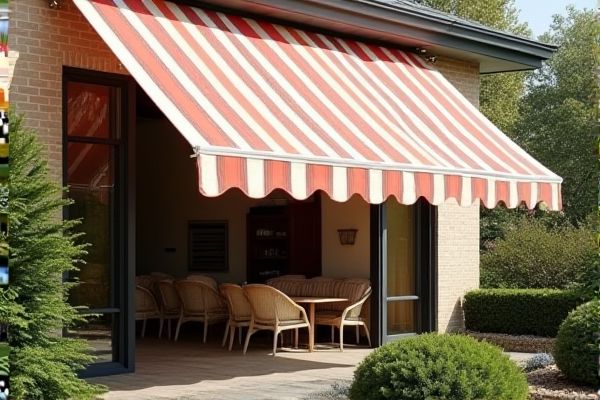
Striped awnings offer a dynamic, eye-catching design that adds character and visual interest to your outdoor space, while solid awnings provide a sleek, uniform look that complements a variety of architectural styles. Explore the pros and cons of both options to determine which awning best suits your aesthetic preferences and functional needs.
Table of Comparison
| Feature | Striped Awning | Solid Awning |
|---|---|---|
| Appearance | Patterned with alternating colors, vibrant look | Single color, clean and uniform style |
| Sun Protection | Effective but patterned light limitations | Maximum sun blockage, solid coverage |
| UV Resistance | Good UV protection, depends on fabric | High UV protection, often premium fabrics |
| Durability | Moderate, depending on fabric quality | Typically high, better fade resistance |
| Maintenance | Easier to hide stains with patterns | Shows dirt more, needs frequent cleaning |
| Style Suitability | Casual, playful, or traditional settings | Modern, sleek, and formal environments |
| Price Range | Generally affordable | Varies, often slightly higher |
Introduction: Striped vs. Solid Awnings
Striped awnings feature alternating bands of color that create a visually dynamic and classic look, often enhancing curb appeal and adding a sense of playfulness to outdoor spaces. Solid awnings provide a uniform color that delivers a sleek, modern aesthetic while maximizing shade coverage without visual distraction. Choosing between striped and solid awnings depends on desired style impact, with striped awnings offering pattern and vibrancy, and solid awnings emphasizing simplicity and versatility.
Visual Impact: Style and Curb Appeal
Striped awnings create a dynamic visual impact by adding vibrant patterns and color contrasts that enhance your building's style and curb appeal. Solid awnings offer a sleek, minimalist look that provides uniform shading and a timeless aesthetic, complementing various architectural designs. Choosing between striped and solid awnings depends on your desired statement, whether bold and eye-catching or subtle and elegant.
Color Options and Design Flexibility
Striped awnings offer a vibrant variety of color combinations, allowing for dynamic visual appeal that can enhance the architectural character of any building. Solid awnings provide a more uniform and versatile color palette, making them ideal for businesses or homes seeking a sophisticated, understated look. Both options deliver design flexibility, with striped styles adding playful contrast and solids offering expansive customization through fabric texture and finish.
Light and Shade Control
Striped awnings allow partial sunlight to filter through the gaps between the stripes, creating a dynamic interplay of light and shade that enhances outdoor ambiance. Solid awnings provide consistent, uniform shade by blocking sunlight entirely, offering superior protection from UV rays and reducing heat beneath. Your choice between striped and solid awnings will depend on whether you prefer variable natural light or maximum sun protection.
Maintenance and Cleaning Differences
Striped awnings often require more frequent cleaning due to their patterned fabric, which can highlight dirt and stains more prominently than solid awnings. Solid awnings typically show less wear and may mask minor spots, reducing the need for constant maintenance. Regular upkeep of your awning ensures longevity and keeps the fabric looking vibrant regardless of the design.
Durability and Fading Resistance
Striped awnings often feature multiple colors, which can fade unevenly over time, whereas solid awnings typically retain their color more uniformly due to a single dye process. Both striped and solid awnings made from high-quality, solution-dyed acrylic fabrics offer excellent durability and superior resistance to UV fading, ensuring longer-lasting appearance and performance. Choosing the right fabric and protective treatments enhances Your awning's lifespan regardless of pattern style.
Suitability for Residential Spaces
Striped awnings offer a lively and decorative appearance, making them ideal for residential spaces seeking a vibrant and classic charm. Solid awnings provide a sleek, modern look with versatile color options, enhancing curb appeal while offering maximum sunlight protection. Homeowners often choose striped designs to complement traditional architecture, whereas solid awnings suit contemporary and minimalist home styles.
Commercial Applications and Branding
Striped awnings enhance commercial applications by increasing visibility and attracting customers with bold, eye-catching patterns that reinforce brand identity. Solid awnings offer a clean, professional appearance ideal for businesses seeking a minimalist look and consistent color branding. Choosing between striped and solid awnings depends on the desired impact on customer perception and alignment with the business's branding strategy.
Cost Comparison: Striped vs. Solid Awnings
Striped awnings often come at a slightly higher price due to the complexity of fabric patterns and printing processes, while solid awnings tend to be more cost-effective with uniform fabric production. Your budget should consider not only initial purchase prices but also maintenance costs, as striped awnings may require more frequent cleaning to maintain their vibrant appearance. Durability and fabric quality impact overall value, making solid awnings a practical choice for long-term cost savings.
Choosing the Right Awning for Your Needs
When selecting the right awning for your needs, consider that striped awnings offer a dynamic, visually appealing design that can enhance curb appeal while providing effective sun protection. Solid awnings deliver a sleek, uniform appearance ideal for modern aesthetics and often better block sunlight and rain. Your choice depends on whether you prioritize decorative style or maximum coverage and durability.
 homyna.com
homyna.com